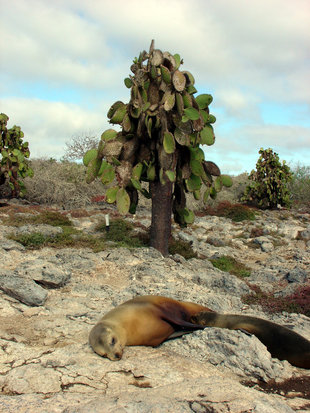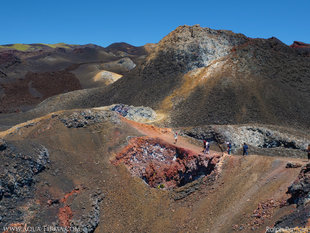Giant tortoises, volcanoes, sharks, flamingos, marine iguanas, turtles, sealions and penguins - these privately-guided hotel-based trips feature some of the best of the Galapagos islands' wildlife, marine life, and scenery. These trips are particularly good for topping up species and areas you may not have come across on a boat based natural history or diving trip. For those with only a short time to spare, they are also highly rewarding trips in their own right.
If we first consider the central southern coast of Isabela, including its small offshore islands: sealions are the largest creatures we find here; very often right under our feet, so we have to take care to step around them. Marine iguanas are similarly littered in many places - on pathways through mangroves and along lava trails; but most rewardingly viewed on rocky shorelines, sometimes in their many hundreds draped over each other, reheating their bodies ready to go freediving for algae. Las Tintoreras islands provides us with one of the best opportunities in the Galapagos we have of snorkeling with them.
Large Green Turtles are another snorkel highlight at this location; and from above water we can often see dozens of sharks swimming in lava tunnels no more than 1 foot deep. In a different areas far to the West, mangrove systems and shallow caves further west provide us with some of the best opportunities to snorkel close to Black-tip Reef Sharks, amongst schools of juvenile Golden Cownose Rays and yet more Green Turtles.
Back to the central southern parts of Isabela, salty inlets and pools amongst mangroves provide excellent habitat for flamingos, with easy opportunities to film and photograph them. Yellow legs, moorhens and Darwin's finches are also easily spotted in these habitats.
Of volcanic scenery, southern Isabela is home to a volcanic crater second only in scale to Tanzania's Ngorongoro Crater. Volcan Sierra Negra is 6 miles (10 km) across! To reach the closest point of the crater edge involves an overland drive and then a between 45 mins to 1 ½ hour hill walk. On a dry sunny day this can be relatively easy. When cloud comes in and there is rain, we have to pick our way more carefully. The summit can often be seen from the southern coast, but on days when cloud obscures a view, we can often trek above this layer for clear views across the crater. When you reach the crater edge, the scale of the landscapes is difficult to absorb.

The ultimate aim is to trek along the crater edge to Cerro Chico. This parasitic cone erupted spectacularly in 2005, just when the BBC were filming a series called Islands that Changed the World. Just beneath the surface, the rocks can be very hot, with lava tunnels running in all directions. It is essential to stick to marked trails here, because apparently solid rock can be very thin, with large voids beneath. The stark scenery here is very beautiful and views from this area extend far north to the enormous Elizabeth Bay and Fernandina Island.
Of other life, brightly coloured Sally Lightfoot Crabs can be seen in many locations on this trip; along with Lava Gulls, Nazca Boobies and Blue Footed Boobies, including nesting sites in the remote south west.

Photographically, wildlife and underwater video opportunities are wonderful on this trip. A GoPro or housing to a camera or video is recommended for snorkelling opportunities, whilst on land you would do well with wide angle, standard and telephoto capability.
Itinerary
4 Days Isabela based itinerary
Please note that itinerary order may be adjusted to optimise for tides and to fit in with your transport to and from Isabela Island.
Day 1: Puerto Ayora to Puerto Villamil, Isabela
This itinerary begins at the largest town in the Galapagos: Puerto Ayora on Santa Cruz Island, helping you onto a speed boat to Isabela Island from there. We can adjust and start this from Baltra Island airport or San Cristobal Island, getting you to Isabela Island by small plane.
Assuming you begin in Puerto Ayora, our representative will help you onto a shared speed boat running to Puerto Villamil on Isabela Island. When you reach there, collect your bags, pay the US$20 landing fee and then walk past sealions and marine iguanas to where immigration control will check your luggage for potential contaminants such as nuts or seeds.
Right there, our driver will be waiting to help with your bags and drive you to your beachside hotel. You will pass by the central plaza where there are several restaurants. There is also a bar and restaurant next door to the hotel – so plenty of choices within 5 minutes of your hotel. It will not be long before the sun sets over the ocean nearby.
Day 2: Volcan Sierra Negra & Las Tintoreras Islets
Our first objective for you is to take you as far from the ocean as is possible in the Galapagos; to the edge of the world’s second largest volcanic crater.
After breakfast, you will be collected from the hotel by 4WD and taken north to the lower slopes of Volcan Sierra Negra. You will then start trekking through guava trees and native flora to the rim of the crater. Depending upon the weather, the trek will take about 45 mins to 1 ½ hours. When dry the walk is easy. Fog and rain can make it slippy.
The rim of the crater is just the start of trekking opportunities. You will next set off along the crater edge and later to the caldera of Cerro Chico which last erupted in 2018. The lava formations of tunnels and puffing fumeroles are wonderful to explore. The views can also be breathtaking.
After your trek you will be taken back to sea level.
In the afternoon you will be taken first overland and then by boat to Las Tintoreras - a set of islets close to the shore of Isabela. These beautiful islets, with their blue waters, vibrant green vegetation and stark black and white volcanic rocks, provide opportunities to see a huge amount of wildlife and marine life. This includes white tip sharks, basking in shallow waters of a lava tunnel; hopefully Galapagos penguins; marine iguanas at all stages of development; Galapagos sealions; Pacific green turtles; lava lizards; black octopus; bright orange Sally Lightfoot crabs, Blue-footed boobies and more.
On land you will be able to walk slowly amongst the lava observing and photographing the flora and fauna at close range. You will also be able to snorkel in a lagoon where we can often snorkel close to multiple Green Turtles and find marine iguanas crossing from one side to the other right next to us. There is some coral in the lagoon where we can sometimes see Mexican Hogfish and Spotted Eagle Rays. Sometimes we see black-tip reef sharks and even Galapagos penguins underwater.
Day 3: Lava Tunnels of Far Southwestern Isabela / Lagoons & Tortoise Breeding Project
You will be collected from your hotel and taken to where you will board a speed panga (small shared boat). This will take you along the coast, pass an impressive bird-roost rock, before riding the surf into an area of dozens of tiny lava islets. In the water we might see huge Galapagos Green Turtles and out of the bare rock grow some impressive opuntia cactus trees. We also usually find blue-footed booby nesting sites.
After exploring here, you will head east again, calling into a bay surrounded by well-established mangroves and lines of lava out to sea. Snorkelling here may seem modest at first, but keep searching and you have in prospect the chance to see black-tip reef sharks, golden cow nose rays, seahorses and green turtles - often at very close range amongst mangroves and lava rocks.
You will have lunch on the boat in calm water before heading back to southeastern Isabela. On what should be a very memorable day in the Galapagos, your guide will take you walking along beaches and beside lagoons with wonderful opportunities for spotting seabirds, marine iguanas and Sally Lightfoot crabs. You will also be guided around a Giant Tortoise Breeding Project.
In the late afternoon you can either enjoy your hotel and facilities; or take a stroll onto one of the most beautiful golden sands beaches in South America's eastern Pacific. There is also a boardwalk close by which is excellent for spotting Darwin's finches, snapes and marine iguanas in amongst mangroves. A similar boardwalk a few hundred yards away is often and ideal point from which to see flamingos.
Day 4: Depart Isabela
You have two choices for leaving the island: speed boat or flight. Flights within the Galapagos restrict your baggage to 15kg with no room for carry on luggage. A speed boat does not have this restriction.
Assuming speed boat, you will need to get up in the dark and step onboard the boat just before daybreak. You will then speed eastwards where at Puerto Ayora you will be met and transferred to a private car. This will drive you right across Santa Cruz Island where we will help you onto a foot ferry and then the airport bus on Baltra Island.
Flights from Isabela will be late morning, taking you directly to Baltra airport …. or San Cristobal airport if that fits with your wider schedule.
Dates
US$ 1,890
4 days / 3 nights per person sharing privately guided - includes inter-island transfers by boat.
Add £75 / $95 pp to fly on your last day to Baltra airport or San Cristobal.
from US$ 1,850
Small group trip starting & ending Baltra airport, including inter-island transfers
Private trip prices
(price per person sharing - available throughout the year subject to availability of guides and accommodation)
Prices include
Privately guided
Accommodation
All meals (fixed menus)
All transportation starting Puerto Ayora & ending Baltra airport - combination of shared & private
Snorkel equipment
Prices exclude
Wetsuit rental
Items of a personal nature
Tips
Flights to / from Galapagos (but we can arrange)












